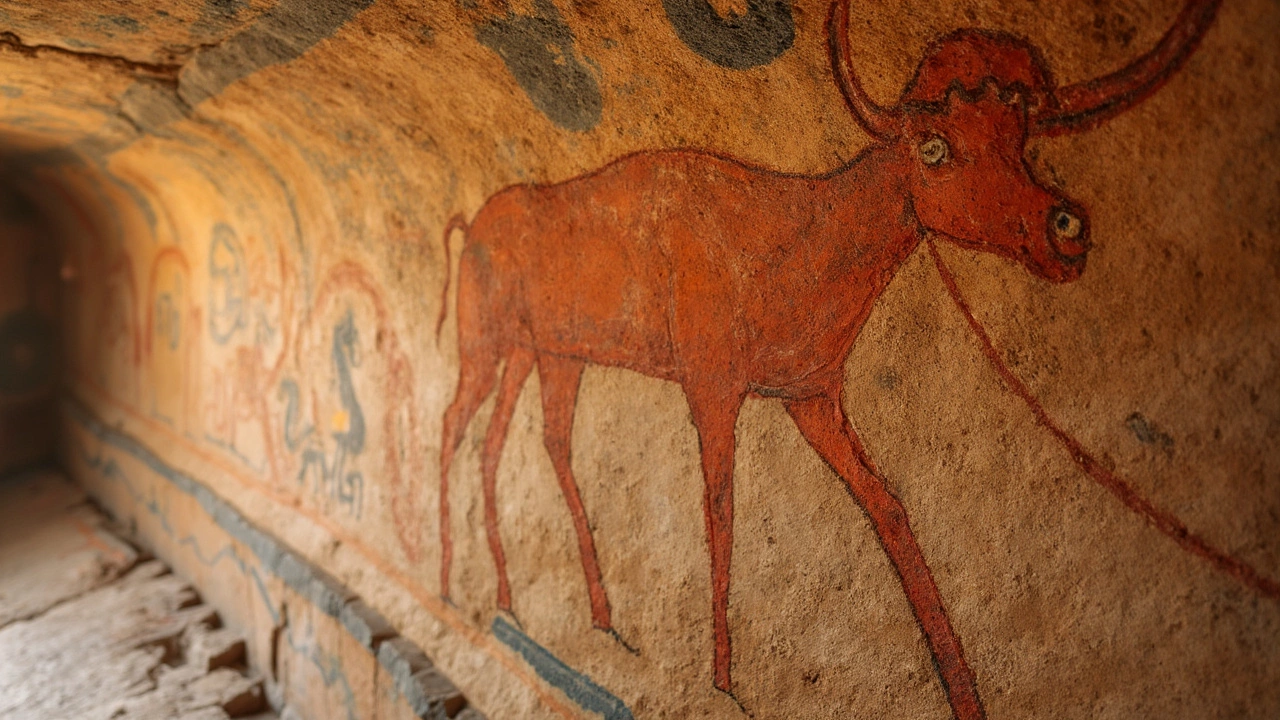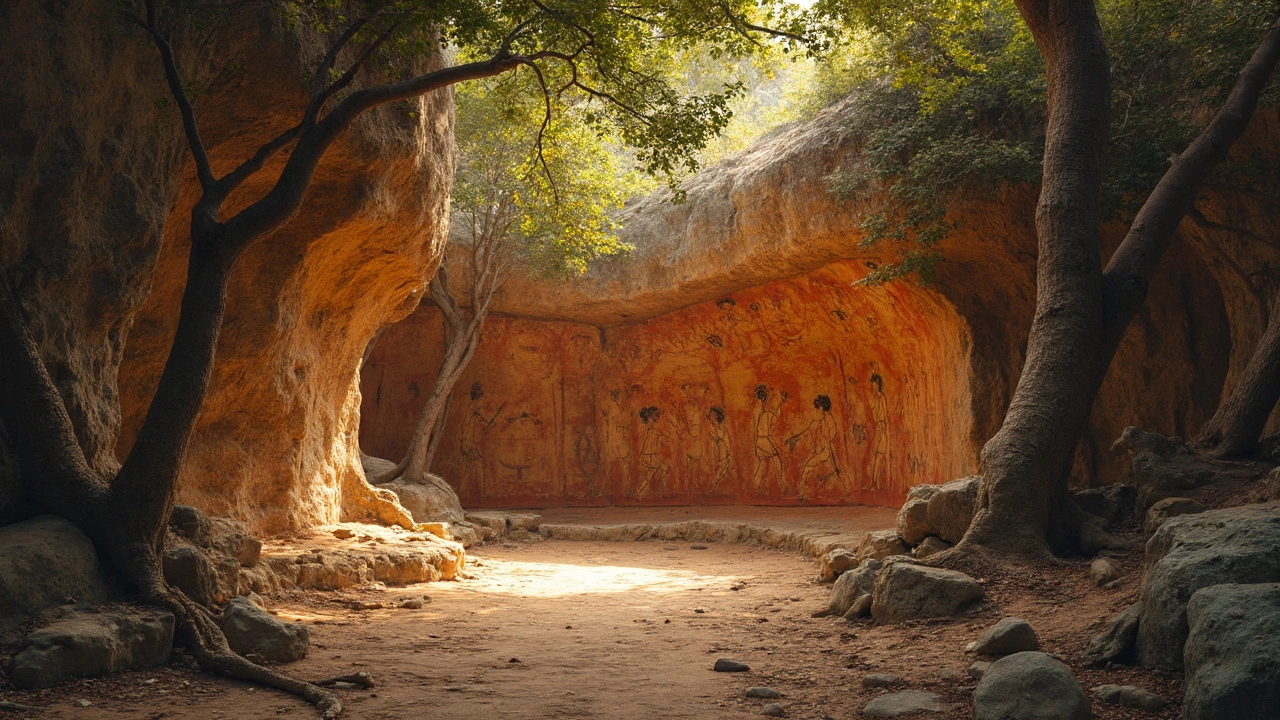Imagine standing in front of a piece of art created over 30,000 years ago. That's exactly the experience you get at the Bhimbetka rock shelters in India. These awe-inspiring cave paintings aren't just marks on stone; they're the heartbeats of human creativity from the dawn of time.
These shelters are located in Madhya Pradesh, tucked away in the Vindhya Range, a place where prehistoric art comes alive. The paintings depict scenes of hunting, dancing, and the natural world, giving us a window into the lives of our ancestors. They're not just scratches on a wall; each line and stroke tells a story of survival, community, and creativity.
Why does this matter today? Well, apart from being an art lover's dream, these paintings offer a rare glimpse into early human culture. They show us how humans started to understand the world around them, putting their experiences into visuals for posterity. And let's not forget their importance in the history of art, standing as a testament to the enduring human spirit of expression.
Now, preserving these artworks is a big deal. Time and nature have had their say, but through careful conservation efforts, these paintings continue to teach us and inspire future generations. They are a crucial part of India's cultural heritage, and their study helps us unravel the rich tapestry of human history.
- Introduction to Bhimbetka
- Exploring the Cave Paintings
- Significance of the Artworks
- Preservation and Study Today
Introduction to Bhimbetka
Begin your journey into prehistoric time at the Bhimbetka rock shelters, a fascinating site nestled in the heart of India, specifically in the state of Madhya Pradesh. It's a protected area about 45 kilometers south of Bhopal.
Recognized as a UNESCO World Heritage site in 2003, Bhimbetka is more than just a tourist spot; it's a gateway to understanding the dawn of human creativity. The site's discovery dates back to the 1950s, thanks to the efforts of archaeologist Dr. Vishnu Wakankar, who stumbled upon these masterpieces quite by accident.
The Geography and Scale
The area is surrounded by dense forests, adding an element of adventure to any visit. Over 750 rock shelters have been identified here, spread across 10 kilometers, though a smaller number, around 500, feature the ancient paintings. If you're a history buff, seeing these ancient art pieces up close is like hitting the jackpot.
The rock formations themselves are stunning, created over time through natural processes. It's believed that these shelters once provided homes to early humans, serving as a canvas for their expressions.
A Timeline Through Art
These paintings aren't just from a single period; they span several eras, from the Paleolithic to the Medieval. Imagine rock art that's around 30,000 to 10,000 years old. The later paintings belong to the historical period, roughly from 10,000 BC to a few centuries ago. The range is mind-boggling.
The paintings are typically ocher or white, using natural pigments, and often depict scenes from everyday life, like hunting or dancing. This creative output offers a valuable look into prehistoric life, a peek into how early humans saw their world.
Exploring the Cave Paintings
Diving into the Bhimbetka rock paintings is like flipping through the pages of a very ancient photo album. These aren't just any old scribbles; they're legit masterpieces that have survived for tens of thousands of years! Let's break it down and see what's happening on these rock walls.
Scenes from Prehistoric Life
So, what did those ancient folks draw? Loads of stuff! There are scenes of people dancing, hunting wild animals, and getting the day's work done. Imagine seeing a group of men armed with bows chasing down a herd of animals. It gives you chills, thinking about the adventure and survival instincts of that time. These weren't just pastime doodles; they were serious business, showcasing their daily lives.
Materials and Techniques
Now, you might wonder, how did they paint all this? Well, these artists, being resourceful as they were, used natural pigments found in vegetables, minerals, and even animal fats. Yeah, those earthy reds, whites, and greens came from the environment around them. It's like nature's palette, and they used it to full effect!
Symbolism and Meaning
There's a lot more than meets the eye. These paintings weren't just for decoration. They might have had symbolic meanings or were used in rituals. Think of them as early 'how-to' guides—a way to teach the younger generation about hunting techniques or social practices.
The beauty of these cave paintings lies not just in their age, which by itself is mind-blowing, but also in their storytelling power. Whether you're a history buff, an art aficionado, or just curious about ancient cultures, Bhimbetka offers a truly unique experience.
There's no denying that exploring these paintings is like unlocking secrets from the past. They continue to raise questions and inspire researchers to dig deeper into understanding how humans have expressed themselves over time.

Significance of the Artworks
The Bhimbetka paintings are not just art; they are a crucial part of understanding early human life and culture in India. These artworks offer a fascinating insight into the minds and lives of prehistoric humans who inhabited the area thousands of years ago.
The Cultural Window
First off, these paintings are like a time machine—they take us back to a period where storytelling was done through art. They show us how our ancestors viewed their world, from hunting experiences to everyday activities like dancing and social gatherings. It’s clear that art was a significant part of their lives, possibly used for rituals or as a means of communication.
Artistic Techniques
The techniques used in these paintings are also noteworthy. Created using natural pigments, these artworks have stood the test of time. The use of red and white pigments is dominant, made from substances like hematite and limestone. Some paintings even feature shades of green and yellow, which were rarer and achieved through mixing minerals. The choice of materials shows an early understanding of color and composition.
An Educational Resource
For educators and history buffs, the Bhimbetka paintings serve as an educational goldmine. They’re part of an ancient storytelling tradition that reflects the evolution of human thought and expression. Schools often include these artworks in their history curriculum to give students a tangible connection to our ancient past.
Inspiring Modern Artists
These ancient pieces of art continue to inspire modern artists today. The simple yet profound lines and figures found on these cave walls influence contemporary artists who seek to incorporate timeless elements into their work. It's a reminder of the enduring power of creativity.
Remember, these artworks aren't just part of India's history; they're a slice of human history, showing the shared origins of our artistic impulses. Protecting and studying them not only honors our shared past but inspires future generations to appreciate the roots of creativity.
Preservation and Study Today
Preserving the Bhimbetka rock shelters is a massive task, blending modern science with a deep respect for history. Over the years, conservationists in India have implemented various measures to maintain these ancient artworks, ensuring future generations can enjoy and learn from them.
Conservation Efforts
The Archaeological Survey of India (ASI) plays a leading role in the conservation of these sites. They regularly clean the rock surfaces, being incredibly careful not to damage the historic paintings. They also educate local communities on the value of these treasures and their role in protecting our shared heritage.
Challenges and Solutions
The biggest threats come from natural weathering and human activities. The ASI has set up protective barriers and signage, helping visitors appreciate these masterpieces without adding to their wear and tear. Conservationists also use advanced technology, like 3D scanning, to create backups of the artworks for future study and restoration work.
Another key part of this work involves balancing tourism with preservation. Measures include limiting the number of visitors at any one time and ensuring pathways are clearly marked to reduce unintended damage.
Academic Research and Studies
Researchers from around the world study ancient Indian art to understand more about early human life in India. The detailed scenes offer clues about social structures, the environment, and even interactions with other groups. Recently, a study revealed that some paintings might be from slightly different time periods, showing evolving styles and purposes.
| Preservation Activity | Outcome |
|---|---|
| 3D Scanning | Digital preservation and detailed study material |
| Visitor Limits | Reduced impact from tourism |
| Local Community Education | Increased community engagement and participation in preservation |
It's not just about keeping the rock shelters safe; it's about telling their story in a way that resonates with people today. These vibrant scenes of history are an invaluable resource, deepening our understanding of humanity's great journey. Without ongoing study and preservation, these windows to ancient life could fade away, just like the stories they tell.
